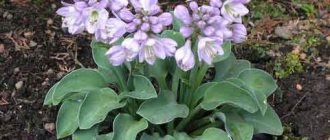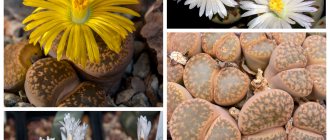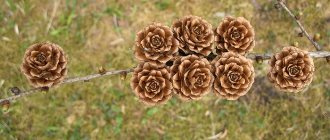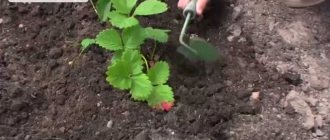“The sea splashes in the land of magnolias...” The words from a once popular song are not entirely relevant today. The magnolia family is very diverse. There are deciduous and evergreen magnolias, and they come in the form of small shrubs and tall trees. But they all have one thing in common - incredibly beautiful flowers that can fill your garden with an indescribably pleasant aroma, even if you do not live in the subtropics. Yes, today magnolia is increasingly becoming a resident of regions with temperate climates. In this article I will tell you and show in the photo how I grow magnolias from seeds.
How I grow magnolias from seeds
Where can I get a suitable magnolia seedling?
The only question is where to get it - magnolia, and how to choose the right one for your region? The easiest way is to go to your local botanical garden and/or garden center and explore their selection. If magnolias grow and are sold, then they can grow in yours too.
There is, however, one difficulty here - the cost of seedlings is high, and not everyone can afford to risk money with an unpredictable result (after all, magnolias may not survive the first harsh winter). It is advisable to play it safe by learning how to propagate magnolia yourself in large quantities, so that in the event of a particularly harsh winter you will have a supply of your own seedlings.
Magnolia propagation by cuttings
An excellent way to completely preserve the varietal characteristics of a plant, but this is difficult and not for everyone. It is advisable to take cuttings in the spring and from young plants. That is, you should already have such a plant in yourself or your friends. And the temperature regime should be strictly observed (+22…+25 degrees).
Magnolia propagation by layering
The method has the same advantages - all varietal characteristics are completely preserved, but even here it is necessary to have the mother specimen “at hand”. And there are not always branches convenient for bending them to the ground and securing them in this position for the entire rooting period.
Propagating magnolia by seeds is not a quick process, but, in my opinion, it is interesting. That’s what we’ll talk about in more detail today.
Magnolia blooms very early, earlier than most trees. © Igor Bilevich
There are deciduous and evergreen magnolias, and they come in the form of small shrubs and tall trees. © Igor Bilevich
Magnolia blooms for a whole month. © Igor Bilevich
Collecting magnolia fruits
Magnolia blooms very early, earlier than most trees, in April, and some species even in March. Although grandiflora magnolia blooms in summer (but this is a completely southern option). In recent years, due to climate change, re-blooming may sometimes occur around the end of summer.
Magnolia blooms for a whole month. The flowers are large, bright, up to 20 cm or more in diameter. Depending on the variety, the flowers can be white, pink, purple, red, lilac, plain or with borders and stripes.
By autumn, fruits form from the flowers. In some species they are cylindrical, in others they resemble cones.
These are the fruits we will collect. The easiest way to do this is in botanical gardens or parks, in the area where they are grown. However, it is worth understanding that, having collected magnolia fruits in the southern regions, there is no guarantee that the plants grown from them will survive your colder winter.
A hybrid for every taste
When purchasing and planting a magnolia seedling, you should keep in mind that from sowing the seeds to the first flowering it will take at least
Those magnolia seedlings that are sold in stores may contain a catch. The fact is that businessmen bring them from Europe: Poland, Hungary, Holland, Germany and even Northern Italy. The climate in Europe is much milder than in Russia or Ukraine, so you are taking a risk because you are not sure that the “foreign plant” will not freeze over next winter, and given the high prices for large seedlings, you may be deeply disappointed in your purchase.
Read also Hidden wiring in a wooden house with your own hands
The compromise option is this: you should purchase plants about 1 m high in containers, but certainly with at least one or two flower buds. Such magnolia seedlings cost much less, and using the example of one or two flowers you will be convinced of the correctness of your choice.
Magnolias grow very quickly and are able to adapt well to local climatic conditions. Note that young plants have significantly higher adaptation capabilities than large magnolia seedlings.
For example, 7 years ago I purchased a seedling of the hybrid magnolia Sulange Alexandrina (Magnolia soulangeana) about 60 cm high; it bloomed for the first time the next year and grew in height every year.
Today this slender tree is about 4 m high, blooms profusely, the flowers are large pink, fragrant. Flowering lasts about a month, and in September-October the fruits ripen; they also give the tree an unusual appearance.
Most magnolia seedlings that are commercially available are hybrids of wild magnolias. Breeders have developed hundreds of varieties with flowers of all shades and shapes.
Magnolia Yellow Bird
The most popular among gardeners are various forms of magnolia Sulange, obtained by crossing magnolia bare with magnolia lily. These include Magnolia Alexandrina, Magnolia Ammabilis (creamy white), Form Linne (large cupped white and pink flowers), Rosea (pink flowers) and my favorite Verbanica (large goblet shaped, ivory flowers).
For the abundance of bright flowers and easy care, gardeners love such hybrid magnolias as: Susan, Betty, George Henry Kern, Leonard Messe (hybrid Lebner magnolia).
I recommend the tree magnolia Vadas Memory, which is a hybrid of the loosestrife magnolia and the Kobus magnolia. It blooms profusely with large snow-white flowers with the aroma of citrus and anise.
Hybrids that bloom with yellow flowers are becoming increasingly popular. In my garden, Yellow River magnolia with creamy yellow goblet-shaped flowers and Yellow Bird with rich lemon-yellow flowers have taken root well.
When choosing magnolias, you should keep in mind that hybrids are more capricious and often freeze slightly in harsh winters, although they have a wide variety of shapes and colors.
Preparing seeds for stratification
Now you need to extract the seeds themselves from the fruits. In magnolias, the seeds are surrounded by a red oily shell (scientifically called sarcotesta). This shell protects the seeds from drying out. Dried magnolia seeds lose their viability. That’s why don’t buy dry seeds, they should either be in their natural shell or packed in something wet.
The next step, perhaps, is not entirely pleasant - we clean the seeds from this very juicy shell (sarcotesta). The easiest way to do this is with your fingernails.
Cleaned magnolia seeds should be washed in water with added liquid dishwashing detergent. This is necessary in order to wash away the remaining oily liquid that protects the seeds (it prevents their germination).
Magnolia fruits. © Igor Bilevich
Cleaning magnolia fruits. © Igor Bilevich
We wash the peeled seeds. © Igor Bilevich
Magnolia seed stratification
We send fully prepared seeds for stratification (we will explain this in more detail here). The seeds of some plants contain substances that prevent their premature (autumn) germination. But these substances gradually - under the influence of low temperatures and humidity - disintegrate by spring, and the seed is able to germinate. This process can be entrusted to nature, but in the case of seeds of rare plants (and magnolia is one of them), it is better to carry it out under control.
Sphagnum is well suited for the stratification process (sand, perlite, vermiculite, neutral peat can be used). Sphagnum moss should be soaked in water for about 20 minutes and then squeezed out well.
We place magnolia seeds in damp sphagnum or other damp and loose substrate, trying to cover them on all sides. We place this entire “mixture” in a plastic container with a lid (a plastic bag will do) and place it in the bottom (vegetable) drawer of the refrigerator.
With proper adjustment, the temperature there is constantly maintained at +4...+5 degrees, which is ideal for magnolia stratification purposes. We forget for three months... no, of course, we don’t forget, but periodically, about once every 2-3 weeks, we open and inspect the seeds (that’s why a container is more convenient than a bag).
Read more about seed stratification in the material 6 rules for stratifying seeds at home.
If they are dry (although they shouldn’t be), lightly moisten them; if they become moldy, then rinse them in water (possibly with potassium permanganate). If you start this process around mid-October, when the seeds are collected, then after the Old New Year the seeds should already show readiness for germination; their outer shell will burst. It's time to move on to the next stage.
Magnolia seeds in sphagnum moss on stratification. © Igor Bilevich
Preparing seeds for planting
Growing magnolia from seeds at home is a rather complicated process. It requires an individual approach. Therefore, amateur flower growers try to learn as much as possible about sowing grains.
Before germinating magnolia seeds, you need to prepare them in advance and process them properly. You can buy planting material in specialized stores. It is recommended to sow grains directly into open soil. This is done in the fall from September to November. If you want to plant a flower in a greenhouse in winter, they need to be frozen until then.
Stratification refers to the special modeling of the effects of climate and environmental conditions on a plant (for example, cold and moisture). This is a very important process for the plant. It affects the successful outcome of reproduction and further cultivation of magnolia. The most optimal temperature for stratifying magnolia seeds is + 5˚C.
Hardening is not yet a 100% condition for success. Without observing all temperature standards and basic care rules (temperature ranging from +1˚C to +5˚C with constant soil moisture), the seeds will simply die.
The seeds are frozen using a special technique. They need to be placed in a well-moistened substrate. It consists of leaves, cereal husks, sawdust, hay and other components. Then the container with planting material is transferred to the refrigerator for 21 days. After this time, they are thawed at room temperature and sown in previously prepared and fertilized soil.
Sowing stratified magnolia seeds in the ground
Around mid-January, prepare a container or box (depending on the number of seeds). Don't forget that it should have holes to drain excess water. Fill this container with a good loose and fertile mixture. Additions of vermicompost (for nutritional value) and vermiculite (for moisture retention) are welcome.
Sow stratified magnolia seeds into this mixture to a depth of 3 cm and place the crops on a light and warm windowsill. Although light is not necessary yet. In fact, the seeds will need another two months to appear “into the light of day.” And don’t forget to water the seemingly empty container all this time.
By March 8, the first magnolia shoots should appear; this is where plants need light, so they need a south-facing window sill and artificial lighting.
At this stage, differences in growth rates between species are clearly visible. My fastest growing magnolias were Soulanges, Lebner and obovate, large-flowered. Although this may be due to differences in soil mixture and location (this issue has been poorly studied).
And then - regular watering and, if desired, fertilizing with fertilizers for seedlings. Magnolias are quite tenacious and, with good care, grow well even in the first year. In different species, their height during the first season ranges from 10 cm to 30 cm.
Of course, the described process can be simplified by immediately sowing the seeds, without cleaning and washing them into the soil mixture, and storing them in the refrigerator or basement, but, as practice shows, germination will be lower. If you need 1-2 magnolia seedlings, do so, but if you are aiming for a large number, then it is better to use the proven technology described above.
What to do at the end of the growing season with grown magnolia annuals? In southern regions with rare and not severe frosts, they can be safely planted in the ground, only sometimes when the temperature drops below 0, giving them an easy shelter. In the northern regions, where frosts are constant in winter, planting should be delayed until spring, or better yet another year, so that the seedlings become stronger. Seedlings of deciduous magnolias should overwinter at a temperature of +0...+5 degrees, or without light (in the basement).
This year's magnolia seedlings. © Igor Bilevich
Magnolia - a tree of unique beauty
The beautiful delicate plant magnolia kobus evokes a special charm in the spring with its fragrant large flowers, and during the growing season it attracts the eye with unusual decorative leaves and very bright fruits.
Magnolia is propagated by seedlings or cuttings, but this tree can also be grown from seeds. This process is labor-intensive and requires great effort and care from the gardener.
How to germinate magnolia seeds
Before planting, magnolia seeds must be cleared of their cover. To do this, the fruit is left at room temperature for some time; when the seeds fall out, they are immersed in water for 2-3 days. For better cleaning, swollen seeds should be rubbed through a sieve, then washed in soapy water (use only laundry soap). This is done in order to rid the magnolia seeds of oiliness, then they need to be thoroughly washed with soapy water; if these procedures are not carried out, they will most likely become moldy.
Planting magnolia
Choose a place to replant the plant in a high place without stagnant water. The plant does not tolerate getting wet and becomes damp. Magnolia seeds can be sown in open ground, making deep furrows of at least 10 cm.
Crops are insulated for the winter with dry mulch or leaves in a layer of 20-25 cm. In spring, the insulation is removed along with the top layer of soil to a sowing depth of 3-5 cm. If you leave the soil as is, the seedlings will lag behind in development in the first year.
The best option would be to sow magnolia seeds in a deep container with soil around December. The depth of the container is important, since the plant has a long tap root, and if there is not enough space for its development, the plant will wither. Water thoroughly and cover the top to prevent the soil from drying out. Store the container in a basement with a temperature of 0 +5 degrees. In early spring you can move it to a warm, bright room. Seedlings are planted in open ground in the second year; magnolia should be watered very carefully, since in the early vegetative period the plant is susceptible to the disease “blackleg”.
Home care
Magnolia loves permeable, fertile soil. It is preferable to choose a place in the garden in partial shade and protected from server winds. Magnolia kobus, grown from seeds, blooms for 8-12 years. Although magnolia kobus tolerates winter very well, during the first two winters, after planting the tree in open ground, the ground must be insulated with dry material, and the crown must be surrounded with branches of spruce branches in the form of a hut, or carefully wrapped with covering material.
Planting magnolia seedlings in open ground
When planting magnolia seedlings in open ground, you should carefully choose the location. Magnolia has fragile roots and does not like transplants from place to place and experiences them painfully.
You should choose a place that is protected from winds and drafts, with plenty of sun, and in the southern regions, on the contrary, slightly shaded.
Magnolia does not like heavy, clayey, sandy, waterlogged and calcareous soils (capricious, but beautiful), so prepare the planting hole and soil mixture according to all the rules, taking into account its requirements.
Magnolias usually grow actively not in the summer, but in late summer and early autumn.
The seed method of propagating magnolia allows you to grow plants that are resistant to the winters of your region, especially if the seeds are collected from parents growing in colder climates.
Me and my four year old magnolia seedlings. © Igor Bilevich
Rules for planting and care
If you buy a ready-made seedling, inspect it carefully. The root system must be closed.
The choice of soil has already been discussed above. We can conclude that the optimal place for planting magnolia is the sunny side of the garden, protected from wind and drafts, with good and fertile soil.
Most gardeners are of the opinion that seedlings should be planted in the fall. During this period, the tree stops developing. In addition, the frosts have not yet hit the street, but it is no longer hot.
There are several opinions regarding spring planting. Some believe that magnolia can be planted in the spring, like other seedlings. Others are sure that spring planting will destroy the tree. The reason for this is possible frosts, which the fragile tree will not tolerate. Rehabilitation is unlikely to bring positive results.
Of course, each owner decides for himself when to plant seedlings in his garden. But please note that magnolia planted in the fall takes root almost 100%.
After you have decided on the time and place of planting, you can go dig a hole. It is made several times larger than the root system of a tree. A little soil taken from the hole should be mixed with rotted compost. After preparing the ground, the seedling is carefully lowered into the hole and covered with earth. Magnolia roots are delicate, so you can’t go too deep. After planting, a hole should form around the trunk. The soil in it is trampled down and watered abundantly. After water has been absorbed, the circle around the trunk should be mulched or covered with the bark of coniferous trees.
Caring for magnolia is not that serious, but some points should still be given due attention. In the first years after planting, the tree is very demanding when it comes to watering. It needs to be done as often as possible, and with plenty of water. On hot days, drying out the soil is contraindicated.
Watering is, of course, good, but care should be taken to preserve moisture. Mulching will help with this. In winter, mulch retains heat well and in summer it prevents drying out. In addition, it is an excellent source of essential substances that nourish the soil and improve its structure.
In winter, the tree needs to be provided with shelter. Mostly frost-resistant varieties are planted, but insulation is still necessary, as there is a risk of reverse frost. Insulation is carried out by wrapping the trunk with burlap in several layers. They do this very carefully, because magnolia is very fragile and delicate.
In November, you need to take care of covering the trunk. The procedure is carried out as soon as the first frost hits. You might think, why do they cover the frozen ground? Because there are no inhabitants (for example, mice) in the shelter.
If partial freezing of the tree does occur, pruning is carried out in the spring. All branches are cut to the healthy part. Garden varnish is used to lubricate the cut areas. Even if the tree has overwintered successfully, pruning is also necessary. Remove all dry and lifeless branches, and those that have crossed inside the crown.
Formative pruning of magnolia is not required.
Like any other plants, magnolia needs feeding. But you don’t need to do this for the first few years after planting.
Seedlings that have reached three years of age need to receive nutrients. Therefore, in the spring, fertilizing is applied. Fertilize the tree from spring until the end of summer.
Nitrogen fertilizers will be beneficial, but they can only be applied until mid-summer. The reason for this is the increase in freezing.
You can prepare the fertilizer at home yourself. To do this you will need:
- Ammonium nitrate – 20 grams.
- Urea – 15 grams.
- Mullein – 1 kilogram.
- Water – 10 liters.
Everything is thoroughly mixed in one container. One tree should require about 40 liters of solution.
If you do not want to spend time preparing fertilizer, you can purchase it at any flower shop. Products intended for fertilizing magnolia:
- AGRECOL "For magnolia".
- "Kemira-Universal".
The rules for breeding and use are described in detail in the instructions.
On a note! Don't get carried away with fertilizing. Much does not mean good. Excessive feeding can be harmful.
If in the middle of summer you notice that the leaves on your tree are actively turning yellow, this indicates an overdose of drugs. To correct the situation, provide the tree with active watering.
Rodents can cause irreparable damage to a tree; they damage the root collar and roots. Also, you should be wary of moles that undermine the root system. If pests have damaged the trunk, apply a solution of foundationazole (1%) to it.
The spider mite causes great harm; it becomes active during dry days. It sucks out all the vital juices from the inside of the leaf. These leaves die and fall off. To avoid complete infection, inspect the tree more often. At the first sign, remove all affected parts and treat with Actellik. There are other drugs. Before use, be sure to read the instructions.
Disadvantages of seed propagation of magnolias
Of course, this method of propagating magnolias has two significant drawbacks.
- If you like this or that variety, and you managed to find and collect its seeds, unfortunately, you will not receive varietal characteristics as a result. When propagated by seed, only the specific characteristics of this plant are preserved.
- Magnolias grown from seeds will not bloom soon, in 10 years (but time flies!)
But any magnolia is still beautiful! And even more so - grown yourself!











